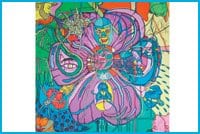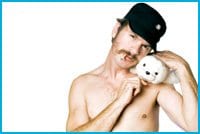
PSYCHEDELIC WRESTLEMANIA. Pile-driving paintings and performance from Scott McEwan. Credit: Paula Wilson
Contemporary art can be boring and inaccessible. Challenging this sad potentiality is Toronto Alternative Art Fair International (TAAFI). Taffy, as it’s commonly pronounced, is rumbling its way through town for the second year with ultra-hip art hotels the Drake and the Gladstone again playing host. In a purposefully cheeky decision, this mix of artists, curators, commercial galleries, not-for-profit art institutions, panel discussions and gala parties is scheduled to take place at the very same time as the well-established Toronto International Art Fair (TIAF) at the Metro Toronto Convention Centre.
Less established and spunkier, TAAFI is collectively organized. The nonprofit curatorial and organizational group is comprised of Toronto art darlings Barr Gilmore (graphic designer, proprietor of Solo Exhibition and former senior design associate at Bruce Mau Design), Andrew Harwood (artist, curator and former proprietor of Zsa Zsa gallery) and Pamila Matharu (artist, educator and founding member of the South Asian Visual Arts Collective). Harwood says the idea for TAAFI was born two years ago at the zine fair Canzine. On that day Harwood says he, Matharu and founding collective member Selena Christo decided to do a fair that “really rocks out.” A gander at TAAFI’s musical roster alone, which includes Stink Mitt, We Are Wolves and Peaches, to name a few, is evidence the fair will indeed rock out. But it isn’t all about music; it’s not even mostly about music. TAAFI is, above all, a celebration of visual art.
Touting itself as “Canada’s only alternative art fair,” prompts the question: Just what is it an alternative to? Harwood does not seem to be a fan of the question. He advises people to attend the fair and experience it directly. The simple answer, of course, is that TAAFI is an alternative to the more corporate TIAF. TAAFI is a homier, more fun and budget-minded affair.
As far as international events go, TAAFI is markedly Canada- and Toronto-centric. But the fair also plays host to artists and work from New York and across the US, as well as Germany. Geography aside, TAAFI sure is bent. The high percentage of queer-con is not strictly part of the fair’s mandate, but rather an extension of who the organizational trio is. “It is just natural for two fags and an out there bi gal to have events and artists that are queer user-friendly,” says Harwood. Although rainbow paraphernalia is not likely to be found at TAAFI, pick any version of queer and you’ll likely find some form of it represented.
Donning multiple TAAFI roles, Gilmore celebrates five years of his gallery Solo Exhibition in room number 202 at the Drake Hotel. In every day life Solo Exhibition is comprised of a small (less than 20 inches wide) storefront window sandwiched up against Dufflet’s Pastries at 787 Queen St W. Much like the space itself, Solo’s motto is succinct: “One window. One artist. One artwork. Every full moon till the next one. Always open.” Admirably, Gilmore says his curatorial mandate is driven by his desire “to expose as many people as possible to contemporary art so that no one is afraid or intimidated to experience it.”
Solo Exhibition has a strong presence in the Toronto art scene. It is an unpretentious forum — gallery isn’t quite the right word — that brings up unique questions relating to audience and space. Add to this the fun factor of Queen St and you have a hit. Solo at TAAFI will be a survey of work from the last five years. Highlights include AA Bronson’s The Hanged Man photograph, Matthias Hermann’s Photo Booth light box and Sandy Plotnikoff’s Hat Scene trucker-hat bedspread. (Currently on display at Solo itself is Denise Oleksijczuk’s Perennial Love, a hand-cranked text scroll.)
Also at the Drake, Toronto-based visual artist Patrick DeCoste presents an installation and “killer” performance titled Baby Seal Club (babe phoque club). DeCoste, best known for creating lush, flesh-laden paintings, veers away from his previous work, opting for something decidedly more crass. Without giving too much away, DeCoste describes Baby Seal Club as being comprised of “three white seal pup piñatas hung from the ceiling, the cute ones with the whitest of fur.” For the performance, scheduled for 5pm on Sat, Nov 5 and 6, Brigitte Bardot, as channelled by DeCoste’s brother, “enters the lounge, the artist holds a club in his hand…,” and it degenerates from there. Don’t forget to bring the children. Baby Seal Club is DeCoste’s artificial recreation of the culture of killing on the springtime ice floes in eastern Canada. While there will not be any actual ice floes at the Drake, viewers will no doubt be up to their tits in the profane.
DeCoste says he is interested in TAAFI because of its success at providing a venue for art that is edgy and interesting, calling it “more ballsy and cutting-edge.” If anyone has got balls on his mind, it is DeCoste. From his Silenus In Furs paintings of voluptuous naked men, to his more recent and richly scatological Stag Club (a collaborative installation with Ken Moffatt), DeCoste obsesses over masculinity. Baby Seal Club looks at how hunting is tied to Canadian and masculine identity, as well as the artist’s personal history of hunting small game in Nova Scotia. Either that, or it is an attempt to push people’s buttons.
Speaking of provocation, artist, porn director and local rabble-rouser Bruce LaBruce presents an installation titled Women In Revolt in room number 204 at the Drake. LaBruce describes the installation simply as being comprised of a white room, a television set and a bloody handprint. LaBruce culled clips from his favourite movies, largely from the 1960s and ’70s, and added a soundtrack. He realized most of his choices had an element of masquerade, or were comprised of women in the midst of nervous breakdowns, killing themselves or someone else. LaBruce’s installation is about the creation of melodrama, social control and the appropriation of popular culture.
For those who only know LaBruce’s work as a filmmaker, the idea of an installation may seem like a new direction. Women In Revolt, however, is tied to some of his previous work. In the past few years LaBruce has been involved in similar photo shoot/installations at Los Angeles’s arts’n’culture celebrations, Platinum Oasis and also at Peres Projects, an LA gallery currently representing LaBruce’s work. If the idea of a man making work using images of hysterical women seems suspect, step right up to the interrogation line. LaBruce is the first to ask if the installation is just offering “an excuse to be misogynist like so many other homosexual men.” Ambiguously, he does not offer anything resembling an answer.
From the disturbing to the sexy, or perhaps disturbingly sexual, even the TAAFI parties are about ideas. One of the art fair highlights includes a Saturday night party called Boner, a cabaret style event with headliner Peaches featuring a gay pile drive-a-thon. Get out your gear and prepare to be pummelled by event organizers and artists Scott McEwan and John Caffery. Through an ever-evolving process, McEwan has managed to turn his interest in wrestling into a fetish, a lifestyle and an art. Aside from the obvious sexual overtones, his interests also lie in exploring the masculinity, movement and spectacle of wrestling in his paintings. His work can be seen on the TAAFI catalogue cover. McEwan’s psychedelic paintings are a visual freak out of pilfered images from old magazines and personal Internet liaisons.
If after visiting TAAFI, whooping it up at the parties and rooting through all the installations, performances and videos, the art world still seems boring it might just mean the cynicism monster has swallowed you whole. Though the experience of an art fair can be taxing, and at times less than ideal, the TAAFI collective have the very best of intentions: To provide a venue for provocative, engaging art that is accessible to everyone.
***
At the Drake, look for room installations by photographer Guntar Kravis and videomaker and piñata artist Julian Calleros; at the Gladstone, look for art from Paul Petro Gallery and Birch Libralato Gallery, photos by Tobaron Waxman and installations by Allyson Mitchell, Bruno Billio, Christopher House and John Monteith. Also at the Gladstone on Saturday afternoon is a panel with Bruce Barber, Carole Conde, Richard Fung and Darren O’Donnell called Who’s Left? The State Of Left Culture. The opening party at the Gladstone with Stink Mitt, Leslie And The Lys and others, costs $25; doors open at 9pm on Thu, Nov 3. The $25 Boner party at the Drake with headliner Peaches and MC Texass starts at 10pm on Sat, Nov 5. Daryl Vocat has a print exhibition opening Thu, Nov 3.

 Why you can trust Xtra
Why you can trust Xtra


